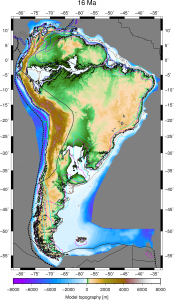 Citation
Citation
Flament, N., Gurnis, M., Müller, R. D., Bower, D. J., & Husson, L. (2015). Influence of subduction history on South American topography. Earth and Planetary Science Letters, 430, 9-18. doi: 10.1016/j.epsl.2015.08.006.
Abstract
The Cenozoic evolution of South American topography is marked by episodes of large-scale uplift and subsidence not readily explained by lithospheric deformation. The drying up of the inland Pebas system, the drainage reversal of the Amazon river, the uplift of the Sierras Pampeanas and the uplift of Patagonia have all been linked to the evolution of mantle flow since the Miocene in separate studies. Here we investigate the evolution of long-wavelength South American topography as a function of subduction history in a time-dependent global geodynamic model. This model is shown to be consistent with these inferred changes, as well as with the migration of the Chaco foreland basin depocentre, that we partly attribute to the inboard migration of subduction resulting from Andean mountain building. We suggest that the history of subduction along South America has had an important influence on the evolution of the topography of the continent because time-dependent mantle flow models are consistent with the history of vertical motions as constrained by the geological record at four distant areas over a whole continent. Testing alternative subduction scenarios reveals flat slab segments are necessary to reconcile inferred Miocene shorelines with a simple model paleogeography. As recently suggested, we find that the flattening of a subduction zone results in dynamic uplift between the leading edge of the flat slab segment and the trench, and in a wave of dynamic subsidence associated with the inboard migration of the leading edge of flat subduction. For example, the flattening of the Peruvian subduction contributed to the demise of Pebas shallow-water sedimentation, while continental-scale tilting also contributed to the drainage reversal of the Amazon River. The best correlation to P-wave tomography models for the Peruvian flat slab segment is obtained for a case when the asthenosphere, here considered to be 150 km thick and 10 times less viscous than the upper mantle, is restricted to the oceanic domain.
Downloads
Influence of subduction history on South American topography
Download the data and supplementary material – zip file
![]()
